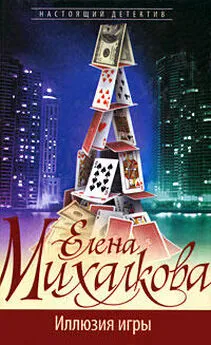Брюс Худ - Иллюзия «Я», или Игры, в которые играет с нами мозг
- Название:Иллюзия «Я», или Игры, в которые играет с нами мозг
- Автор:
- Жанр:
- Издательство:Эксмо
- Год:2015
- Город:Москва
- ISBN:978-5-699-79277-1
- Рейтинг:
- Избранное:Добавить в избранное
-
Отзывы:
-
Ваша оценка:
Брюс Худ - Иллюзия «Я», или Игры, в которые играет с нами мозг краткое содержание
Иллюзия «Я», или Игры, в которые играет с нами мозг - читать онлайн бесплатно полную версию (весь текст целиком)
Интервал:
Закладка:
352
S. Pinker, The Blank Slate: The Modern Denial of Human Nature (New York, NY: Viking, 2002).
353
Известная всем с детства басня И. А. Крылова была русским переложением (1808) басни Эзопа, как и многие другие басни Ивана Андреевича. – Примеч. ред.
354
L. Festinger, A Theory of Cognitive Dissonance (Stanford, CA: Stanford University Press, 1957).
355
Название можно перевести как «Давайте заключим сделку». – Примеч. пер.
356
V.V. Bapeswara Rao and M. Bhaskara Rao, «A three-door game show and some of its variants», Mathematical Scientist, 17 (1992), 89–94.
357
E. Langer, «The illusion of control», Journal of Personality and Social Psychology, 32 (1975), 311–28.
358
D. Salsburg, The Lady Tasting Tea: How Statistics Revolutionized Science in the Twentieth Century (New York, NY: Holt, 2002).
359
G. Gigerenzer, Reckoning with Risk (Harmondsworth: Penguin, 2003).
360
G. Gigerenzer, «Dread risk, September 11, and fatal traffic accidents», Psychological Science, 15 (2004), 286–7.
361
M.E.P. Seligman and S.F. Maier, «Failure to escape traumatic shock», Journal of Experimental Psychology, 74 (1967), 1–9.
362
M.E.P. Seligman, Helplessness: On Depression, Development, and Death (San Francisco, CA: W.H. Freeman, 1975).
363
G.W. Brown and T. Harris, Social Origins of Depression (New York, NY: Free Press, 1978).
364
S.F. Maier and L.R. Watkins, «Stressor controllability, anxiety and serotonin», Cognitive Therapy Research, 22 (1998), 595–613.
365
T.V. Salomons, T. Johnstone, M.-M. Backonja and R.J. Davidson, «Perceived controllability modulates the neural response to pain», Journal of Neuroscience, 24 (2004), 7199–203.
366
S. Botti and A.L. McGill, «The locus of choice: Personal causality and satisfaction with hedonic and utilitarian decisions», Journal of Consumer Research, 37 (2011), 1065–78.
367
B. Schwartz, The Paradox of Choice: Why More is Less (London: Harper Collins, 2005).
368
Склонность постоянно откладывать «на потом» необходимые дела и решения. – Примеч. ред.
369
D. Ariely, Predictably Irrational (New York, NY: Harper, 2008).
370
В данном случае – героиня английской сказки, прототип героини «Трех медведей» Толстого. Сюжеты сказок одинаковы. – Примеч. пер.
371
Многоствольное скорострельное стрелковое оружие, один из первых образцов пулемета.
372
D. Kahneman, «The riddle of experience vs money», TED Talk (February 2010), TED website, www.ted.com/talks/daniel_kahneman_the_riddle_of_experience_vs_memory.html.
373
D.A. Redelmeier, J. Katz and D. Kahneman, «Memories of colonoscopy: A randomized trial», Pain, 104 (2003), 187–94.
374
D. Ariely and G. Loewenstein, «The heat of moment: The effect of sexual arousal on sexual decision making», Journal of Behavioral Decision Making, 19 (2006), 87–98.
375
К психоактивным веществам относятся, например, алкоголь и другие наркотики, в том числе некоторые медицинские препараты. – Примеч. ред.
376
W. James, Principles of Psychology (New York, NY: Henry Holt, 1890).
377
P. Kanngiesser, N.L. Gjersoe and B.M. Hood, «The effect of creative labor on property-ownership transfer by preschool children and adults», Psychological Science, 21 (2010), 1236–41.
378
B.M. Hood and P. Bloom, «Children prefer certain individuals to perfect duplicates», Cognition, 106 (2008), 455–62.
379
B.M. Hood, K. Donnelly, U. Leonards and P. Bloom, «Implicit voodoo: Electrodermal activity reveals a susceptibility to sympathetic magic», Journal of Culture and Cognition, 10 (2010), 391–9.
380
D.J. Turk, K. van Bussel, G.D. Waiter, C.N. Macrae, «Mine and me: Exploring the neural basis of object ownership», Journal of Cognitive Neuroscience, 23 (2011), 3657–3668.
381
S.J. Cunningham, D.J. Turk and C.N. Macrae, «Yours or mine? Ownership and memory», Consciousness and Cognition, 17 (2008), 312–18.
382
У нас принято использовать польское название Освенцим. – Примеч. пер.
383
«Settlement reached over Auschwitz suitcase», Auschwitz-Birkenau Memorial and Museum website (June 2009), http://en.auschwitz.org.pl/m/index.php?option=com_contentandtask=viewandid=630andItemid=8.
384
M. Carroll, «Junk» collections among mentally retarded patients», American Journal of Mental Deficiency, 73 (1968), 308–314.
385
По имени гоголевского персонажа из «Мертвых душ». Синдром был впервые описан нашим выдающимся психиатром Ганнушкиным, поэтому получил такое название. – Примеч. ред.
386
P. Sherwell, «Hoarder killed by collapsing clutter», Daily Telegraph (22 January 2006).
387
R.W. Belk, «Possession and the extended self», Journal of Consumer Research, 15 1988), 139–68.
388
Перевод по Б. Худу, в стилистике оригинала. – Примеч. пер.
389
R. Thaler, «Toward a positive theory of consumer choice», Journal of Economic Behavior and Organization, 1 (1980), 39–60.
390
D. Kahneman, J.L. Knetsch, R.H. Thaler, «Anomalies: The endowment effect, loss aversion and status quo bias», Journal of Economic Perspectives, 5 (1991), 193–206.
391
E. van Dijk and D. van Knippenberg, «Trading wine: On the endowment effect, loss aversion, and the comparability of consumer goods», Journal of Economic Psychology, 19 (1998), 485–95; J.L. Knetsch, «The endowment effect and evidence of non-reversible indifference curves», American Economic Review, 79 (1989), 1277–84.
392
J.R. Wolf, H.R. Arkes and W.A. Muhanna, «The power of touch: An examination of the effect of duration of physical contact on the valuation of objects», Judgment and Decision Making, 3 (2008), 476–82.
393
B. Knutson, G.E. Wimmer, S. Rick, N.G. Hollon, D. Prelec and G. Loewenstein, «Neural antecedents of the endowment effect», Neuron, 58 (2008), 814–22.
394
A. Kogut and E. Kogut, «Possession attachment: Individual differences in the endowment effect», Journal of Behavioral Decision Making (20 April 2010): doi:10.1002/bdm.698.
395
M. Wallendorf and E.J. Arnould, ««My favorite things»: A cross-cultural inquiry into object attachment, possessiveness, and social linkage», Journal of Consumer Research, 14 (1988), 531–47.
396
C.L. Apicella, E.M. Azevedo, N. Christakis and J.H. Fowler, «Isolated huntergatherers do not exhibit the endowment effect bias» Invited talk: New York University for Neuroeconomics, New York.
397
M.H. Kuhn and T.S. McPartland, «An empirical investigation of self-attitude», American Sociological Review, 19 (1954), 68–76.
398
W.M. Maddux, H. Yang, C. Falk, H. Adam, W. Adair, Y. Endo, Z. Carmon and S.J. Heine, «For whom is parting with possessions more painful? Cultural differences in the endowment effect», Psychological Science, 21 (2010), 1910–17.
399
A.P. Bayliss, A. Firschen, M.J. Fenske and S.P. Tipper, «Affective evaluations of objects are influenced by observed gaze direction and emotional expression», Cognition, 104 (2007), 644–53.
400
R.C. Kessler, P. Berglund, O. Demler, R. Jin and E.E. Walters, «Lifetime prevalence and age-of-onset distributions of DSM-IV disorders in the National Comorbidity Survey Replication», Archives of General Psychiatry, 62 (2005), 593–602.
401
R.B. Zajonc, «Social facilitation», Science, 149 (1965), 269–74.
402
G. Porter, B.M. Hood, T. Troscianko and C.N. Macrae, «Females, but not males, show greater pupillary response to direct than deviated gaze faces», Perception, 35 (2006), 1129–36.
403
J.W. Michaels, J.M. Blommel, R.M. Brocato, R.A. Linkous and J.S. Rowe, «Social facilitation and inhibition in a natural setting», Replications in Social Psychology, 2 (1982), 21–4.
404
S.J. Karau and K.D. Williams, «Social loafing: A meta-analytic review and theoretical integration», Journal of Personality and Social Psychology, 65 (1993), 681–706.
405
S. Moscovici and M. Zavalloni, «The group as a polarizer of attitudes», Journal of Personality and Social Psychology, 12 (1969), 125–35.
406
I. Janis, Groupthink (New York, NY: Houghton Mifflin Company, 1982).
407
В тексте песни звучит призыв: «Ты тоже можешь прыгнуть, давай, прыгай!» – Примеч. пер.
408
«DJ condemned for playing Van Halen's Jump as woman leaps from bridge», Daily Mail (18 January 2010).
409
L. Mann, «The baiting crowd in episodes of threatened suicide», Journal of Personality and Social Psychology, 41 (1981), 703–9.
410
T. Postmes and R. Spears, «Deindividuation and antinormative behavior: A meta-analysis», Psychological Bulletin, 123 (1998), 238–59.
411
M. Bateson, D. Nettle and G. Roberts, «Cues of being watched enhance cooperation in a real-world setting», Biology Letters, 2:3 (2006), 412–14.
412
E. Diener and M. Wallbom, «Effects of self-awareness on antinormative behavior», Journal of Research in Personality, 10 (1976), 107–11.
413
V. Bell, «Riot psychology», blog posted on the Mind Hacks website (2011), www.mindhacks.com.
414
Интервал:
Закладка:










